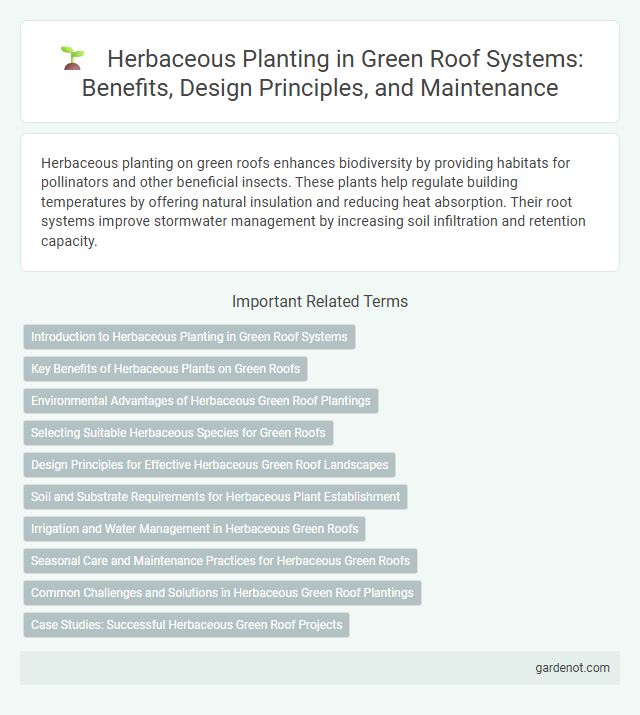Herbaceous planting on green roofs enhances biodiversity by providing habitats for pollinators and other beneficial insects. These plants help regulate building temperatures by offering natural insulation and reducing heat absorption. Their root systems improve stormwater management by increasing soil infiltration and retention capacity.
Introduction to Herbaceous Planting in Green Roof Systems
Herbaceous planting in green roof systems enhances biodiversity and improves stormwater management by incorporating non-woody plants such as grasses, perennials, and flowering species. These plants are selected for their adaptability to shallow soil substrates, drought tolerance, and ability to provide seasonal visual interest while supporting pollinators. Proper establishment of herbaceous layers contributes to thermal insulation, extends roof lifespan, and promotes urban ecological benefits.
Key Benefits of Herbaceous Plants on Green Roofs
Herbaceous plants enhance green roofs by improving biodiversity and supporting local ecosystems through their varied root structures and flowering cycles. These plants contribute to superior stormwater retention and thermal regulation, reducing urban heat island effects and lowering building energy costs. Their adaptability and low maintenance needs make them ideal for sustainable green roofing, promoting ecological resilience in urban environments.
Environmental Advantages of Herbaceous Green Roof Plantings
Herbaceous green roof plantings enhance urban biodiversity by providing essential habitats for pollinators and native wildlife, contributing to ecological balance. These plants improve air quality by filtering pollutants and sequestering carbon dioxide, which mitigates urban heat island effects. Their root systems aid in stormwater management by increasing water retention and reducing runoff, thereby lowering the risk of flooding and water pollution.
Selecting Suitable Herbaceous Species for Green Roofs
Selecting suitable herbaceous species for green roofs involves prioritizing drought-tolerant, low-maintenance plants with shallow root systems that thrive in shallow substrate layers. Sedum spp., native wildflowers, and grasses such as Festuca ovina are popular choices due to their resilience, ability to improve biodiversity, and minimal irrigation needs. These species contribute to thermal regulation, stormwater management, and extended green roof longevity when matched with site-specific climatic and substrate conditions.
Design Principles for Effective Herbaceous Green Roof Landscapes
Effective herbaceous green roof landscapes prioritize plant species with shallow root systems and high drought tolerance to ensure sustainability and reduced maintenance. Incorporating diverse native perennials enhances ecological resilience, supports local biodiversity, and improves stormwater management. Structural considerations include lightweight, nutrient-rich substrates and proper irrigation design to promote healthy growth and long-term system stability.
Soil and Substrate Requirements for Herbaceous Plant Establishment
Herbaceous planting on green roofs requires a well-draining substrate with a balanced nutrient profile to support root development and moisture retention. A lightweight growing medium composed of organic matter, sand, and mineral components ensures proper aeration and prevents waterlogging. Optimal soil pH ranges from 6.0 to 7.5, promoting nutrient availability for vigorous herbaceous plant establishment and growth.
Irrigation and Water Management in Herbaceous Green Roofs
Herbaceous green roofs require precise irrigation strategies to maintain optimal moisture levels and support plant health while minimizing water waste. Implementing drip irrigation systems combined with soil moisture sensors ensures targeted water delivery, reducing runoff and enhancing water use efficiency. Efficient water management promotes sustainable growth of herbaceous plants, contributing to the green roof's environmental benefits such as stormwater retention and urban heat island mitigation.
Seasonal Care and Maintenance Practices for Herbaceous Green Roofs
Herbaceous green roofs require seasonal care to maintain plant health and optimize ecosystem services, including targeted irrigation during dry periods and periodic weeding to prevent invasive species. Regular inspection for pest infestations and application of organic fertilizers in early spring support robust growth and flowering cycles. Seasonal pruning and removal of dead plant material enhance air circulation and reduce the risk of disease, ensuring long-term roof vitality and performance.
Common Challenges and Solutions in Herbaceous Green Roof Plantings
Herbaceous green roof plantings often face challenges such as drought stress, shallow substrate limitations, and wind exposure, which can hinder plant survival and growth. Implementing drought-tolerant native species, optimizing growing media with water-retentive properties, and installing windbreaks or protective barriers can significantly improve plant resilience. Regular maintenance practices, including irrigation management and periodic substrate replenishment, further enhance the long-term performance of herbaceous vegetation on green roofs.
Case Studies: Successful Herbaceous Green Roof Projects
Case studies of successful herbaceous green roof projects demonstrate substantial benefits in urban biodiversity enhancement and stormwater management. For example, the Chicago City Hall herbaceous green roof, spanning 38,800 square feet, reduced rooftop temperatures by up to 30%, contributing to energy savings and improved air quality. Similar projects in New York and Berlin highlight increased native pollinator populations and significant reductions in urban heat island effects through strategic selection of drought-tolerant herbaceous plants.
Herbaceous planting Infographic

 gardenot.com
gardenot.com